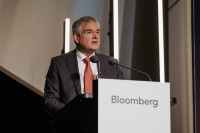
ESG hasn’t disappeared. It is simply speaking a different language.
In an era where ESG investing has become a political target and regulatory scrutiny is high, you might expect investors to run for the exits. Yet against the odds — and the headlines — Europe’s ESG funds are holding firm.
A new Morningstar study reveals a paradox at the heart of sustainable investing in 2025. On the surface, a wave of fund rebrandings suggests retreat, as does 8.6 billion dollars in global net outflows from these funds in the first quarter. Over 640 European funds have stripped or swapped ESG-related terms from their names in the past fifteen months, racing to comply with the EU’s new anti-greenwashing rules. Words like “ESG” and “sustainability” are vanishing from prospectuses, replaced by terms like “screened,” “transition,” or “leaders.”
But a closer look tells a different story.
No mass exodus
Despite regulatory clampdowns and a backlash, especially in the United States, there has been no mass exodus from ESG strategies. The global outflow contrasts with restated inflows of 18 billion dollars in the fourth quarter of 2024.
Europe recorded its first quarterly outflow in sustainable funds since 2018, at 1.2 billion dollars, but this is minor compared to the 2,700 billion dollars still invested. Globally, ESG assets stood at 3,160 billion dollars at the end of March, Morningstar said. ESG remains embedded in portfolios — just under a different guise.
‘No systemic bleeding’
 “At first glance, it seems that inflows into ESG funds have stalled, but there is no systemic bleeding,” said Ismet Soyocak, ESG and critical minerals lead at SFA Oxford, a UK-based consultancy focused on commodities and technology. “Despite a turbulent geopolitical and regulatory backdrop, including political rollbacks in the United States and temporary regulatory softening in Europe, I believe several fundamental factors are sustaining investor confidence in ESG funds.”
“At first glance, it seems that inflows into ESG funds have stalled, but there is no systemic bleeding,” said Ismet Soyocak, ESG and critical minerals lead at SFA Oxford, a UK-based consultancy focused on commodities and technology. “Despite a turbulent geopolitical and regulatory backdrop, including political rollbacks in the United States and temporary regulatory softening in Europe, I believe several fundamental factors are sustaining investor confidence in ESG funds.”
Morningstar’s head of sustainable investing research, Hortense Bioy, agreed. “ESG fund assets remain high because the outflows remain limited, new products continue to be launched, and stock and bond markets remain supportive in terms of valuation,” she told Investment Officer.
Soyocak noted that ESG investing is no longer seen as niche or values-driven. “It is now widely recognised as an essential part of managing financial and physical risk, especially regarding climate change,” he told Investment Officer. “Extreme weather events and transition risks are increasingly priced into the market, and ESG frameworks provide a structured way to navigate these risks.”
335 funds changed name in Q1
Europe’s asset managers are facing a wave of ESG fund rebrandings ahead of ESMA’s anti-greenwashing guidelines, which take effect on 21 May. Some 335 sustainable products changed names in the first quarter, including 116 that dropped ESG-related terms, according to Morningstar. Ninety-four European ESG products were liquidated or merged, while United States fund closures reached a record twenty.
 Morningstar’s Bioy said the impact of the fund renaming activity on the Morningstar’s universe of ESG funds remains to be clarified. “Our data analysts are currently reviewing the funds that have changed names. Our universe of ESG funds, as we define it at Morningstar, may be impacted in the coming months. It’s too early to tell the extent of that impact right now.”
Morningstar’s Bioy said the impact of the fund renaming activity on the Morningstar’s universe of ESG funds remains to be clarified. “Our data analysts are currently reviewing the funds that have changed names. Our universe of ESG funds, as we define it at Morningstar, may be impacted in the coming months. It’s too early to tell the extent of that impact right now.”
Navigating new requirements
The rebranding surge is less about abandoning ESG principles and more about navigating new requirements, according to people familiar with fund branding. ESMA now demands that funds back ESG claims with 80 percent of assets aligned to environmental or social goals, plus exclusions for fossil fuels and other controversial sectors.
For many, that is a bridge too far. Dropping the label while keeping the strategy is easier. Funds such as PGIM European Corporate Bond quietly removed ESG from titles but continue applying ESG screens behind the scenes. Amundi’s thematic ETFs did the same, while managers across Europe and the United Kingdom adapted to comply with ESMA and the UK’s Sustainable Disclosure Requirements (SDR).
Overpromised
 “We didn’t overpromise, which I think is what a number of people have done, often unintentionally,” said Catriona Marshall, head of sustainable investment at Comgest, in an interview with Investment Officer. ESG analysis, she insisted, remains core to their investment DNA, regardless of what the fund name says.
“We didn’t overpromise, which I think is what a number of people have done, often unintentionally,” said Catriona Marshall, head of sustainable investment at Comgest, in an interview with Investment Officer. ESG analysis, she insisted, remains core to their investment DNA, regardless of what the fund name says.
Even in the United States, where anti-ESG rhetoric has escalated into legislation, firms such as Natixis have changed names but not investment processes. The market may be cooling its language, but not its convictions.
 Comgest’s Benelux director, Lodewijk van der Kroft, sees opportunity in the retreat, citing new momentum for ESG strategies, especially in response to investor demand. The firm plans to launch a new ESG fund for investments in the United States. “We feel that there is actually momentum created to launch this ESG version of our classic America fund because of that pullback,” Van der Kroft said.
Comgest’s Benelux director, Lodewijk van der Kroft, sees opportunity in the retreat, citing new momentum for ESG strategies, especially in response to investor demand. The firm plans to launch a new ESG fund for investments in the United States. “We feel that there is actually momentum created to launch this ESG version of our classic America fund because of that pullback,” Van der Kroft said.
Marshall added the fund will target European investors who need to invest in the United States within ESMA standards. “We are going somewhat against the grain with the introduction of Comgest Growth America ESG Plus. We are hearing a lot of scepticism and negativity about ESG issues from the United States, but that does not alter the fact that European investors may have a need to invest in the United States within the standards of ESMA regulations,” she said.
Repositioning, not unwinding
SFA Oxford’s Soyocak said the flow data show that the ESG market is going through a repositioning phase, with investors recognising the differences between temporary volatility and the longer-term shift toward sustainability.
“Markets naturally respond to shocks, reposition, and move on, and this seems like one of those repositioning phases rather than a systemic unwinding,” he said.
The new dictionary for ESG investors

Source: Morningstar Sustainalytics Research.














